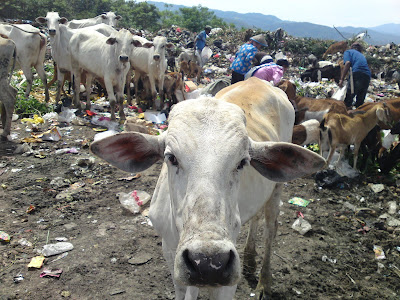(A wondering tiny cow that looked at me when I got her photo)
Sunday, February 27, 2011
Waste refinery in poor countries
Dumping the wastes is a global facts, and we can see that all around the world. However, there are some businesses around these dumping stations. There are scanvengers whose business is to find some valuable materials and collect and sell them. In addition, there are animals such as cows that find their daily meals among the wastes. It means Cows are our current "wastes refineries" in the world, that eat our wastes and then we eat their beef!!

(A wondering tiny cow that looked at me when I got her photo)
(A wondering tiny cow that looked at me when I got her photo)
Saturday, February 12, 2011
Inauguration of fruit wastes to electricity plant
On the last Thursday (10 Feb. 2011), we had a great day in Yogyakarta, Indonesia. In this day, a biogas plant located in a fruit market had kick-off. In this plant, the wastes of the fruit, which is about 4 tons/day is fed the the two digesters (each one 100 m3) and the produced biogas is convetered to electricity (about 500 KWh/day). The electricity is used for the market and also the residents aroud it. It is the first concrete result of our international work "waste recovery" in which our university, polititions, Borås Energy and Environment and SP are working together with the Indonesian partners, Gadjah Mada University, Sleman Municipality and Bionat company. It is a concrete example of "waste biorefinery". Read more about it at wasterecovery.se (in English) and hb.se (in Swedish)!


(The fruit wastes and the final preparations by the Swedish and Indonesian companies before starting of the micro-generators)
(The fruit wastes and the final preparations by the Swedish and Indonesian companies before starting of the micro-generators)
Tuesday, February 8, 2011
Biogas: A threat or rescuer of the global environment?
Biogas is in principle a mixgure of methane and carbon dioxide. Nature is producing biogas since billions years ago. but today:
Scenario 1:
Biogas is a threat to the global environment. It is produced by landfills, rice fields, ponds, cattles etc., and has a great contribution to the global warming. One ton of methane has similar effect as 21 tons of CO2 on the global warming. So, biogas is obviously a threat!
Scenario 2:
Biogas can be produced in a very small reactors, e.g. 0.1 liters, until very large reactors such as 10,000 m3. It can be produced by the kitchen waste of a household or a big plant from e.g. organic wastes of a city. The methane is just the "natural gas" and can be easily separated from other gases by a simple water scrubbing. The methane can be used for heating, cooking, lightning, electricity production, or as car fuel, as it is already used in many countries in the world. We have today a network for tranportation of methane, knowledge to produce it and the technology to use it to run our cars or produce electricity. It can be produced all around the world in any sizes, and meet our demand of energy. So, the biogas is the rescuer of our environment!
The human society should decide about scenarion 1 or 2?
Scenario 1:
Biogas is a threat to the global environment. It is produced by landfills, rice fields, ponds, cattles etc., and has a great contribution to the global warming. One ton of methane has similar effect as 21 tons of CO2 on the global warming. So, biogas is obviously a threat!
Scenario 2:
Biogas can be produced in a very small reactors, e.g. 0.1 liters, until very large reactors such as 10,000 m3. It can be produced by the kitchen waste of a household or a big plant from e.g. organic wastes of a city. The methane is just the "natural gas" and can be easily separated from other gases by a simple water scrubbing. The methane can be used for heating, cooking, lightning, electricity production, or as car fuel, as it is already used in many countries in the world. We have today a network for tranportation of methane, knowledge to produce it and the technology to use it to run our cars or produce electricity. It can be produced all around the world in any sizes, and meet our demand of energy. So, the biogas is the rescuer of our environment!
The human society should decide about scenarion 1 or 2?
Subscribe to:
Posts (Atom)
This blog is dedicated to collect some interesting news and developments on biofuels, bioenergies, biomaterials and biological treatments of residuals and wastes, as well as my personal opinions in this field.



